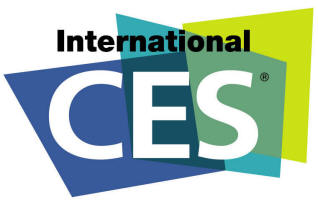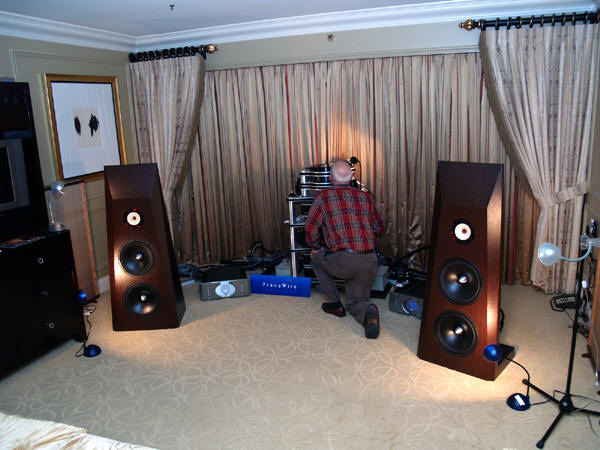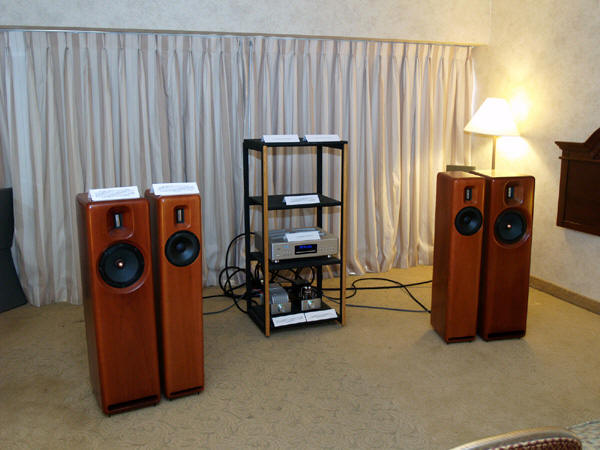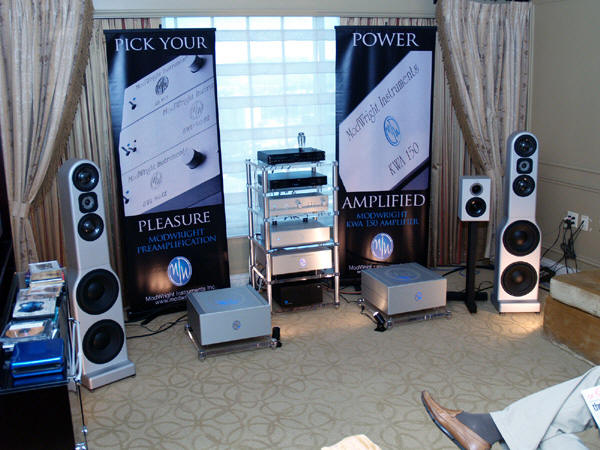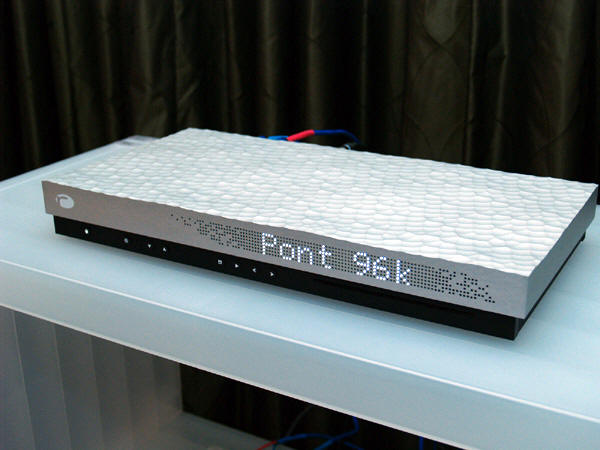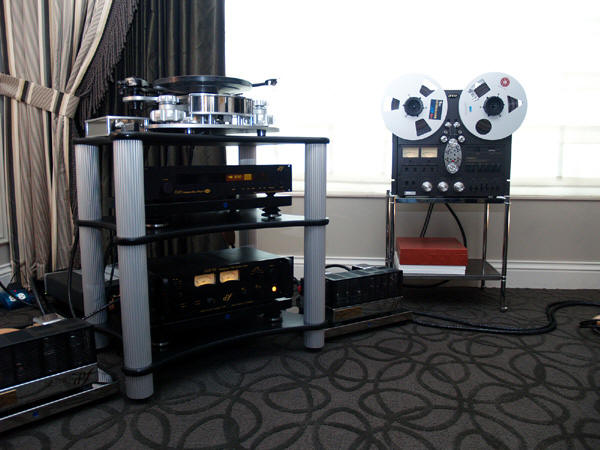|
You are reading the older HTML site Positive Feedback ISSUE 47january/february 2010
CES 2010 - Show Report
Images by Dave Clark Due to the economy many people had been worrying that CES 2010 was going to be a disaster. It is true that this year the number of exhibits and attendees were down. At its peak several of years ago the CES exhibits occupied 3 ½ floors of the Tower at the Venetian Hotel, the three top floors of the Tower (which had the large suites) and numerous large rooms at the Sands Convention Center. At its peak, T.H.E. Show (The Home Entertainment Show) occupied most of the rooms at the St. Tropez. This year only two floors of the Venetian Tower were being used with only a few of the large suites being used on the top two floors of the Tower. There were a few exhibits in the large rooms in the Sands Convention Center. T.H.E. Show was relocated to one floor of the Flamingo Hotel plus the larger rooms in the Flamingo's Business Conference Center. The number of attendees at both the Venetian and the Flamingo were sparse on Thursday, the first day, and the exhibitors feared the worst. On the second day traffic picked up considerably and on Saturday, the third day, the hallways were crowded. Sunday, the final day, was busier than Friday, but considerably less than Saturday. In my conversations on Sunday with exhibitors at both the Venetian and the Flamingo, the exhibitors were very happy with the attendance. Several of the exhibitors commented that while the numbers were down from previous years the quality of the attendees was much higher—meaning that the ratio of lookie-loos versus distributors, dealers, and customers was significantly less than in previous years. CES 2010 turned out to be a very worthwhile convention to attend for both exhibitors and audiophiles. I am looking forward to CES 2011, particularly if the room rates stay down. Vinyl has certainly made a resurgence at CES. A few years ago there were only a few rooms with turntables. This year lots of rooms had turntables and a few rooms were exclusively vinyl. I spent several hours speaking with a number of turntable and tonearm designers regarding future products. Two designers are within a year (?) of releasing a zero tracking error pivoted tonearm. The Thales tonearm (http://www.tonarm.ch/) already does this. However, the Thales is complex and expensive. It will be interesting to see if the designers I spoke with can accomplish zero tracking error at a more affordable price. Two other designers were working on ways to correct for off-center spindle holes. One designer was looking at doing a modern (micro processor) version of the system used on the 1980's Nakamichi Dragon turntable. The other designer, who spent considerable time with me drawing diagrams and explaining the diagrams, seems to have designed a pivoted tonearm that not only has zero tracking error but which can also compensate for off-center spindle holes. The designer believes his design is patentable, so details will not be made public until the patents are filed. It looks like the next few years could be very exciting for vinyl lovers. Listed below, in no particular order, are the rooms that I thought were interesting and/or had excellent sound. While I tried to get to every room, I did not achieve that goal. Some rooms were too crowded every time I stopped by. Other rooms wouldn't let me play my own CDs. And some rooms just played their music too darn LOUD so I didn't even want to venture in. I did compare notes with friends to see if there were any rooms that I had missed that I should have visited For listening, I used CDs that I had compiled from various releases and which I have used at previous CES's and at the Rocky Mountain Audio Fest. The Lotus Group
The Lotus Group was demoing their Granada UB II Loudspeaker with active crossover utilizing the Feastrex Type II Field Coil Driver. The speakers in the demoed version cost $125,000. The other equipment in the room cost an additional $135,000. A good portion of that $135,000 was spent on cables and interconnects. Amplification was by two pairs of Pass Labs XA 30.5 30 watt class A mono block amps for vertical bi-amping ($5500 per pair). Sources were a Hanns Acoustic CD-20 CD player ($2200) and a Hanns T-60 turntable ($6200) with Hanns PA-60 phono stage ($5000). I spent considerable time spread over all four days in the Lotus Group room listening to my test CDs. During those four days four different preamps were used. With two of the preamps the system was nice, but nothing special. With the BAT VK-3iX preamp the sound was spectacular. With the SMc (Steve McCormack) Audio VRE-1 preamp ($8000) in the system on the final day the sound was the best I have ever heard in a demo room. Detail extraction, soundstaging, 3D imaging, naturalness, and conveyance of emotion - no matter what audiophile attribute I listened for it was absolutely superb. No matter what type of music I played - complex orchestral, heavy metal, bombastic soundtracks, violin sonatas, acoustic guitar, and female vocals - the system delivered incredible natural and realistic sound. No, it was not the same as attending a live performance, but close enough that if I could have that sound in my listening room I would be tempted to not renew my season tickets for the symphony. Sonist
The Sonist room was demoing a relatively inexpensive system consisting of the Sonist Recital 3 floorstanding speakers ($1795, $2195 with all wood cabinet) driven by a Glow Audio 832 Stereo Amp with volume control ($795), with cabling by Cable Research Lab. The source was a Cary 306 Pro SACD CD Player ($9000). The Glow Audio 832 amp uses a single 832 transmitting power-beam tetrode. One half of the tube is used for each channel and produces 7 watts per channel. Seven watts is all you need to drive the 93dB efficient Recital 3 loudspeakers to loud volumes. The Glow Audio 832 has a USB port with built-in DAC in addition to the standard RCA inputs. Output is through standard binding posts or headphone jack. For $2600, plus your own source/computer and cables, this Sonist/Glow Audio system was an excellent value for the money. Modwright
The Modwright room was demoing their KWA 150 mono block amps ($12,000 per pair), LS 36.5 preamp ($9000), OPPO BDP-83 CD Player (modified by Modwright $1800), Logitech Transporter DAC (modified by Modwright $4000), and AudioMachina Maestro Ti loudspeakers ($49,000). The system was a little bright in the untreated room, but was very detailed and musical. I went back several times over the four days and enjoyed the sound each time. Morel The Morel room was demoing their floorstanding Fat Lady loudspeaker ($32,000) with a Lindeman 822 integrated amp ($15,000) and cabling by Nordost. The source was a Sim Moon Super Nova CD Player ($6000) as transport and a MSB Technology Power Gold4 DAC ($4000). The Fat Lady loudspeaker cabinets are made from carbon fiber and resin and essentially have no flat surfaces inside or out. The speaker's appearance is a love or hate affair with the lovers and haters seeming to be equally divided. Despite one's opinion on the appearance, most of the people I talked to about the speakers like the sound very much. The Fat Lady is a fairly expensive speaker driven by $25,000 of equipment. However, to my ears the sound was considerably better than that of rooms with much more expensive speakers and equipment. Herron Audio
Herron Audio was demoing their new VTSP-3a preamp, their M1 solid state amplifiers, and another prototype of the Herron loudspeakers. The source was either a VPI Classic turntable with VPI 10.5 tonearm ($2,500) and an Audio Technica OC-9 MLII cartridge ($340) or a Keith Herron modded Magnavox CD player (not available for sale). On the first day the sound in the Herron room was not up to their usual standard. This was due to being in an unfamiliar room at a new venue, the Flamingo Hotel. By the end of the second day adjustments had been made and the sound was excellent. Besides playing lots of vinyl, Keith had some interesting CDs. Keith had refurbished his old reel-to-reel tape deck and had been converting some of his magnetic tapes to digital - stored on a hard drive and then burned to CD-R. One of these CDs was a recording that Keith had made in the late ‘60s of an accordion orchestra. The CD had incredible dynamics, great resolution, and was really fun to listen to - think Spike Jones. Another CD was from a pre-recorded London 2-track tape of the famous Mehta/LA Philharmonic 1971 performance of Holst's The Planets (London CS-6734). I have a number of recordings of that performance on both London and Decca vinyl. I also have the JVC XRCD24 reissue which is the best version that I have heard on either digital or vinyl. Keith was kind enough to give me a CD-R of his 2-track The Planets which I compared to my JVC XRCD when I got home. The JVC CD is slightly quieter and smoother than Keith's digitized version of the 2-track tape. However, after matching volume levels, Keith's version is much more dynamic and sounds more natural. This is a strange world where a digitized version of a 2-track tape made in 1972 can sound better than the best that the current major CD manufacturers can make. Resolution Audio
The Resolution Audio room was demoing their CD player plus power supply ($3500) with their S30 integrated power amp ($2500) using Gradient Helsinki 1.5 loudspeakers ($8000). The Resolution Audio gear is unusual in that the three small modules (25 x 24 x 7 cm) are designed to stack on top of each other with the module on top plugging directly into module beneath it via a bus. No interconnects are needed. The Gradient speakers are unusual looking to say the least. They are also designed to be fairly independent of the room. Weighing only 23kg these floorstanding speakers can easily be moved around the room. While I was listening a number of different speaker positions were tried - close to the side wall, away from the side wall, toed in, toed out, etc. The speakers sounded good in all positions, but some positions sound better than others. If you can't add sound treatments to your room, these are speakers that you should audition in your home. E.A.R.
The E.A.R. USA room was using three different sources: 1) an E.A.R. Acute CD player ($5495), 2) an E.A.R. Disc Master turntable ($17,000) with Helius Omega tonearm ($2900), and 3) an E.A.R. modified Technics 1500 reel-to-reel tape deck using first generation copies of master tapes. The electronics were the E.A.R. 912 preamp ($11,500) and the E.A.R. 509 mono block amps ($14,000). The speakers were the Marten Design Getz ($20,000). Jorma Design Origo interconnects ($5250 per one meter pair) and speaker cables ($7000 per one meter pair) were used. The sound with CDs and vinyl was very nice. However, when the reel-to-reel tapes were used the sound got kicked up to a much higher level. When is mass produced digital going to give us the sound quality of analog reel-to-reel tape?
VMPS Loudspeakers Last year VMPS recorded live music and played it back via their RM60 speakers. Opinions were mixed as to how successful the demo was. I thought it was successful in that while the recording playback sounded like a recording it did convey the emotional energy and much of the tone and texture of a live performance. Brian Cheney, the owner and designer of VMPS, learned a lot about recording and playback from last year's experience. This year, he was back for another live versus recorded demo using a new speaker the RM50 ($12,900). The RM50 is essentially the cabinet of the VMPS VLA (Very Large Array) subwoofer (four 12" woofers mounted in a 6' tall 375 lb. cabinet). For the RM50 the middle two 12" woofers are removed and replaced by several of VMPS's standard midrange panel drivers and several of a new type of ribbon tweeter. On the back of the speaker there are also midrange panel drivers and ribbon tweeters making the RM50 a bipolar loudspeaker. The speakers being demoed were the final prototype. As a result the fit and finish of the speakers were not up to the usual VMPS standards. However, sound-wise the speakers were excellent. I had the opportunity to hear two different live/recorded demos. One with a piano and another with an acoustic guitar. To my ears the recorded playback sound still sounded like a recording. However, this year the playback sound was much closer to the live sound than it had been last year. In talking with other people that heard one of this year's demos and also one of last year's demos, they also felt that this year's demo brought the recorded sound significantly closer to the live sound. I doubt if I will ever hear recorded sound that sounds just like the live performance. However, this year's VMPS live/recorded demo and the sound in The Lotus Group room showed that progress is being made and that recorded sound is getting closer to the sound of live music.
|

